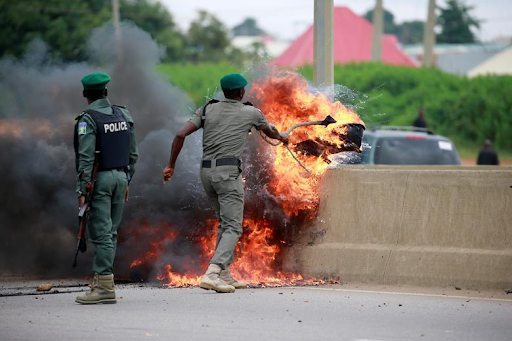Nigeria Police’s Missing Firearms Pose Immense Risk To Public Safety
The Nigeria Police were unable to account for more than 178,459 pieces of firearms in its inventory, according to a government audit report.

The inability of Nigeria Police to account for more than 80,000 military-grade assault rifles, spotlights the country’s security challenges and lax accountability system for state-owned firearms.
An audit by the Auditor-General’s office found that thousands of firearms, including AK pattern rifles, belonging to the Police were missing. The report stated that “The total number of lost firearms as reported as of December 2018 stood at 178,459 pieces. Out of this number, 88,078 were AK-47 rifles.”
The audit report which reviewed the Police’s arms movement register also discovered that 3,907 “assorted rifles and pistols” across different formations could not be accounted for as of January 2020.
These police formations included training institutions, Commands, Zones and the paramilitary arm, known as the PMF or Police Mobile Force.
In one incident, the audit found out that the 21 Police Mobile Force Squadron located in Nigeria’s capital, Abuja, did not report a single case of missing firearms, while the schedule of missing arms obtained from the same Squadron showed 46 missing firearms between 2000 and Feb. 2019.
Apart from missing weaponry, physical verification of firearms and ammunition at the armament unit of the Force Headquarters showed a large quantity of damaged and obsolete firearms which needed to be destroyed.
The revelation was part of the Auditor General’s annual report on non-compliance and internal control weaknesses issues in Ministries, Departments and Agencies sent to the country’s Parliament’s joint Public Accounts Committee.
The report stated that firearms irregularities could be linked to weak internal control systems. It also highlighted potential risks including illegal use, loss of government funds and firearms “getting into the wrong hands.”
Usman Alkali Baba, the country’s Police chief was requested to provide details on the abnormalities observed and to brief the Parliament’s Public Accounts Committee.
The report highlights the issues around accountability in the security sector, weak management of state-owned arms, and the likely impact on security particularly at a time when the government is struggling to tackle various security threats across the country.
The insecurity in the country also contributes to the loss of firearms by Police formations and personnel such as in the Southeast, where, separatist militants have targeted police units just like in the Northeast, where Police officer firearms have been captured in raids and ambushes by insurgents.
Police officers have also been implicated in stealing and transfer of firearms to criminals. For instance, in 2016, the police dismissed 14 police officers for selling arms and explosives to militants and kidnappers.
In March 2021, a police officer working in the armory section of the MOPOL Base 28, in Abia State, Southeast Nigeria was arrested for stealing five assault rifles.
A report by Conflict Armament Research (CAR) published in 2020 traced some of the arms and ammunition linked to herders and farmers conflicts in Northern Nigeria to stockpiles of Nigerian defence and security forces.
The CAR report found Nigerian manufactured small calibre ammunition including cartridges manufactured as recently as 2014 among those used in those conflicts. The country’s Defence Industries Corporation (DICON) has a production line for the manufacture of 7.62mm ammunition.
The report also found other weapons from regional stockpiles and international smuggling sources.
HumAngle has previously documented the role arms trafficking plays in contributing to the violence in the Northwest. The violence is connected to criminality and conflict between pastoralist and farming communities.
During a dialogue meeting in 2021 led by Islamic cleric Ahmad Abubakar Gumi, a distinct looking rifle that bore resemblance to the Valmet M62, a Finnish assault rifle modelled after the AK-47 assault rifle appeared with Kachalla Turji, the leader of an armed group in the region.
The Valmet M62 had no known history with any branch of Nigeria’s military or law enforcement and the most likely source of the rifle was Libya, where it has a history and appeared after the fall of the Muammar Ghaddafi regime in 2011.
Another rifle with international smuggling links is the AK-103, the assault rifle of likely Libyan origin that has frequently appeared in the region with terrorists known locally as bandits.
Nigerian security forces occasionally intercepted transnational smugglers moving illicit arms and ammunition.
Tackling arms proliferation and its associated impacts requires improving accountability and control of weapons stockpiles in armouries of the different security actors in the country in addition to tighter border security measures.
Support Our Journalism
There are millions of ordinary people affected by conflict in Africa whose stories are missing in the mainstream media. HumAngle is determined to tell those challenging and under-reported stories, hoping that the people impacted by these conflicts will find the safety and security they deserve.
To ensure that we continue to provide public service coverage, we have a small favour to ask you. We want you to be part of our journalistic endeavour by contributing a token to us.
Your donation will further promote a robust, free, and independent media.
Donate HereStay Closer To The Stories That Matter




